Keywords
|
| palm print feature extraction, edge detection, multiscale wavelets, Sobel, Canny. |
INTRODUCTION
|
| Automatic human identification which is reliable, user friendly and cost effective is the key issuein today’s information and network based society. Palm print isone of the reliable emerging technology. The palm features like principal lines, wrinkles, ridges, singular points, textures etc. are extracted and are used for person verification and authentication. Many feature extractions techniques are used sofar. Edge detection techniques are widely used in image processing. Palm print feature extraction using edge detection still needs further research. |
| Automatic human identification which is reliable, user friendly and cost effective is the key issuein today’s information and network based society. Palm print isone of the reliable emerging technology. The palm features like principal lines, wrinkles, ridges, singular points, textures etc. are extracted and are used for person verification and authentication. Many feature extractions techniques are used sofar. Edge detection techniques are widely used in image processing. Palm print feature extraction using edge detection still needs further research. and spatial distribution of singularity is effectively done with the help of wavelet transform. The performance of palm print feature extraction using wavelets edge detection gives very promising result. |
| The rest of the paper is organized as follows: Section II contains literature survey. Section III gives palm print feature extraction using multi scale wavelet edge detection. Section IV contains comparison ofSobel withCanny, and at last section V gives conclusion. The poly-U database is used for experimental analysis[2][4][11][12][13]. |
LITERATURE SURVEY
|
| The accuracy of a palm print recognition depends on the palm feature extracted like principle lines, wrinkles, textures etc. Various feature extraction algorithms were developed and used for palm print recognition. Edge detection is most widely used in feature extraction of images in image processing. Conventional edge detections like Canny, Sobel were more popularly used for image feature extraction. The proposed work of application of multi scale edge detection using wavelets for a palm feature extraction involves image acquisition, pre-processing, matching and decision making. Initially ROI of palm is extracted and the features are extracted using the proposed method. The result is compared and analysed with conventional edge detection techniques like Canny and Sobel[1][2][3][4][7][14]. |
PALMPRINT FEATURE EXTRACTION
|
| To evaluate the performance of palm print recognition system, POLY U data base with 600 images of 100 individuals is used. Palm is used as reliable, cost effective,easily acquired person identification modality. The inner palm surface consists of many unique features such as principal lines, ridges, wrinkles, and delta points, which are to be extracted and matched with a larger data set.Initially low pass filter was applied on the image to remove the noise. To distinguish the palm image from the background it is converted to binary image using histogram analysis method. |
| F(x,y) = 255 if f(x,y) _ Gray level. |
| F(x,y) = 0 if f(x,y) _ Gray level. |
| A. REGION OF INTEREST (ROI) |
| Align a specified area and scan the binary image to into it. Select a point P on the palm edge on the X axis and decrement it at specified levels in row wise. Select another point from the bottom edge on the Y axis at same level of P and increment it row wise. If the decrement level is equal to increment level, the outward image is cropped. The procedure is repeated for Y axis point selected on the palm edges. Again assigning a new area specified the entire process is repeated till we end up with center area of the palm. The center of the palm is cropped for feature extraction. |
| B. FEATURE EXTRACTION |
| Jpeg palm image is broken up into small windows and is analyzed using wavelet transform. Mallat defines a wavelet function of a zero average as , |
 |
| Which is dilated with scale parameter s, and translated by u. |
 |
| By correlating the signal with the smoothing function at all possible translation and scale we get continuous wavelet transform due to, scaling and position parameter we get a 2D wavelet transform with variation in frequency and pixel position. The signal keeps the same structure as original but is smoother edges are rounder and contains sharp edges which defines the brightness in the image variation. The multi scale factors are used to obtain more no. of samples in the signal. As a continuous wavelet transform is expensive dyadic method is used where the scales of only powers of two are used. In this method smoothing function is stretched for a selective scale and the process Is repeated from multiple scales where in the wavelet transform contains information for every position in the image. The wavelet transform used with smoothing function is equivalent to canny edge detection where a derivative of a Gaussian is convoluted with the image so that local maxima and minima of the image corresponds to the edges. Using wavelet transform more information on the edges can be extracted. Edges are characterized mathematically by Lipschitz regularity given by |
 |
| Mallat shows that if wavelet transform is Lipschitz α then the function Lipschitz α is : |
 |
| Multi Scale Wavelet Edge Detection Algorithm: The palm image ROI is extracted and a wavelet transform of image is performed using Dyadic scaling levels. At each step the image is convolved with a wavelet to obtain the coefficients at that level it is then smoothed with Gaussian of increasing scale. The wavelet and Gaussian filtering is done. The modulus maxima image combines both the filtered images and is given as |
 |
| The angular image is calculated using |
 |
| Lines of maxima are fond using modulus and angular image .A pixel is modulus maximum if it’s larger than its two neighbours along the angle of gradient vector a pixel considering having 8 neighbours is chosen a threshold is set for a maximum value and a pixel value is chosen. The edge point which is at maxima is gathered and multiscale image edges are formed. The sharpest of all edges are also detected from ROI extracted. |
| C. SOBLE and CANNY EDGE DETECTION |
| Sobel operator performs spatial gradient measurement of an image and finds the region of high spatial frequency that corresponds to edges. Sobel finds the approximate absolute gradient magnitude at each point in input gray scale image. The operator consists of 3x3 convolutions kernels as shown in the figure. One kernel is simply the other rotated by 90 degrees. These kernels are designed to respond maximally to edges running vertically and horizontally relative to the pixel grid, one kernel for each of the two perpendicular orientations. These two can be combined together to find absolute magnitude of the gradient at each point and the orientation of the gradient. The gradient’s magnitude is given by |
 |
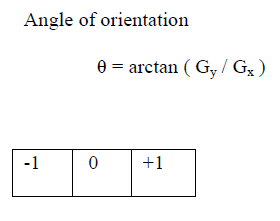 |
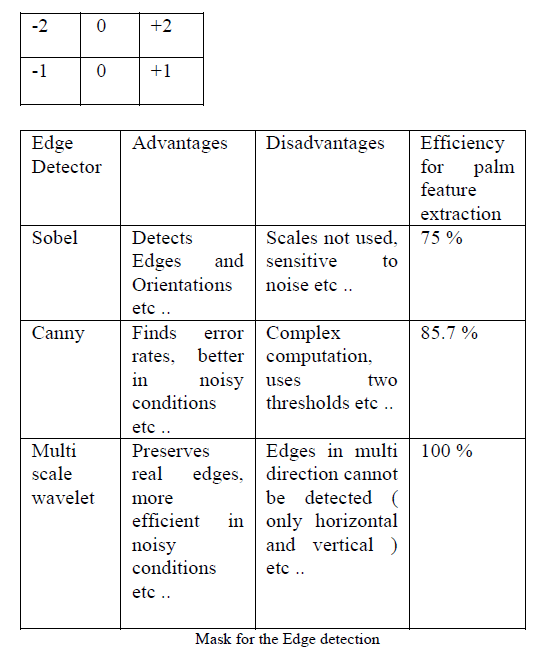 |
| Canny detector is considered to be an optimum edge detector which has a low error rate and also finds the distance between the edge pixels. Canny first smooth’s the image to eliminate the noise and finds the image gradient to highlight the region with a high spatial derivative. The algorithm then tracks along these regions and suppresses any pixel that is not at maximum. The gradient array is further reduced by hysteresis. The hysteresis tracks the remaining pixels that are not suppressed. Canny uses two thresholds and if the magnitude is below the first threshold it is set to zero ( non-edge ) and if the magnitude is above the high threshold it is made an edge ; if the magnitude is between two thresholds it is set zero unless there is a path from this pixel to a pixel with a gradient above threshold two [1][3][5][9][10][11]. |
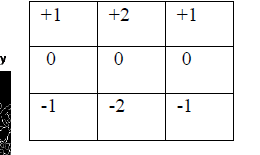 |
COMPARISON of SOBLE and CANNY with MULTI SCALE WAVELET EDGE DECTION
|
CONCLUSION
|
| Feature extraction is a key processing stage for an accurate biometric system. Conventional edge detection techniques are used in feature extraction. Palm print feature extraction using edge detection techniques requires further research. Multi scale wavelet edge detection technique applied for palm print feature extraction gives a promising result compared to Canny and Soble. Future work could be implemented using the combination of the conventional methods to get an accurate palm print biometric system. |
Figures at a glance
|
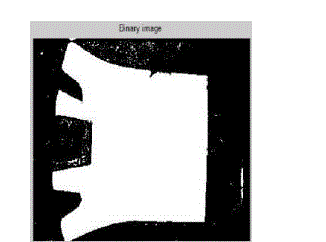 |
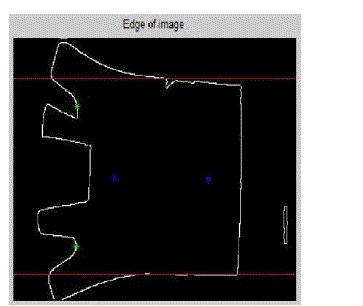 |
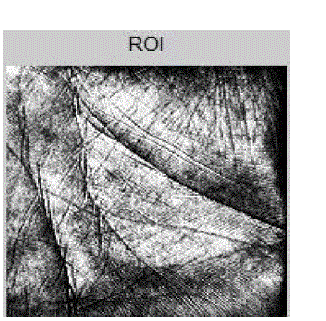 |
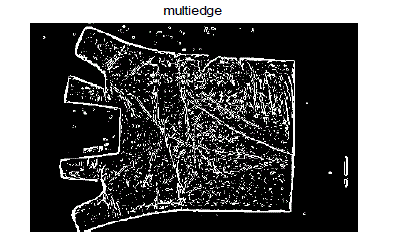 |
 |
| Figure 1 |
Figure 2 |
Figure 3 |
Figure 4 |
Figure 5 |
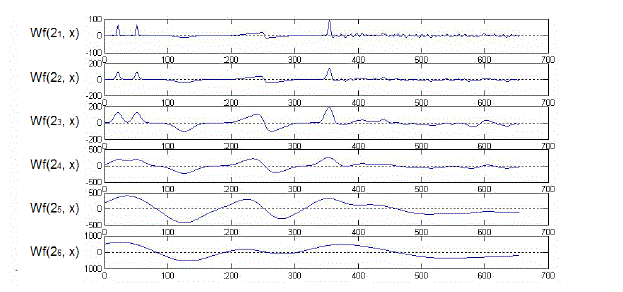 |
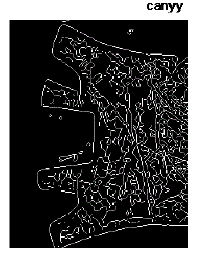 |
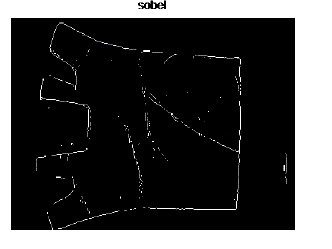 |
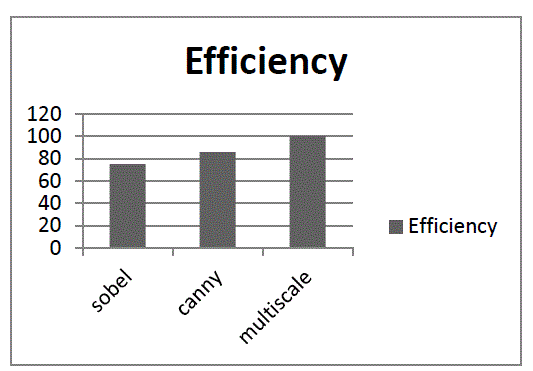 |
| Figure 6 |
Figure 7 |
Figure 8 |
Figure 9 |
|
References
|
- S. Mallat, W. L. Hwang, “Singularity detection and processing withwavelet,” IEEE Tran. Inform. Theory, Vol. 38, No. 2, March, 1992.
- Jun Li, “A wavelet approach to edge detection,” Sam Houston StateUniversity, August, 2003.
- L. Zhang, P. Bao, “Edge detection by scale multiplication in waveletdomain,” Elsevier Science B.V. Pattern Recognition letters 23, pp. 1771-1784, 2002.
- J. Canny, “A computational approach to edge detection,” IEEE Trans.Patt. Anal. Machine Intell., Vol. PAMI-8, pp.679-698, 1986
- Bill Green, “Canny Edge Detection Tutorial,” 2002, available athttp://www.dspguide.com/ch24/7.htm
- Wikipedia. “LipschitzContinuity,”http://en.wikipedia.org/wiki/Lipschitz_continuity.
- T. Peli and D. Malah. “A Study of Edge Detection Algorithms”. ComputerGraphics and Image Processing,vol. 20,pp. 1-21, 1982.
- R. C. Gonzalez and R. E. Woods. “Digital Image Processing”. 2nd ed.Prentice Hall, 2002.
- J. Matthews. “An introduction to edge detection: The sobeledgedetector,” Available athttp://www.generation5.org/content/2002/im01.asp,2002.
- C.K. Chui, ”An Introduction to Wavelets”, Academic Press,Boston,1992.
- J. You, W. Li, D. Zhang, “Hierarchical palmprint identification viamultiple feature extraction”, Pattern Recognition Vol 35 (4) 847–859, 2002.
- A. K. Jain, S. Pankanti, S. Prabhakar, L. Hong, A. Ross, and J. L.Wayman, "Biometrics: A Grand Challenge", Proc. International Conferenceon Pattern Recognition (ICPR) , vol. II, pp. 935-942, Cambridge, UK, Aug.2004.
- A. Kumar and D. Zhang, Personal recognition using shape and texture,IEEE Trans. Image Process., vol. 15, no 8, pp. 2454-2461, Aug.2006.
- E. Argyle “ Techniques for Edge Detection” Pro IEEE, Vol 59, pp 285-286, 1971
|